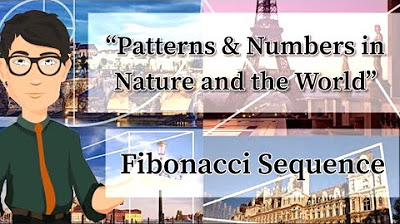PART 1: PATTERNS AND NUMBERS IN NATURE AND THE WORLD || MATHEMATICS IN THE MODERN WORLD
Summary
TLDRThis video explores the fascinating patterns found in nature, which are regular, repeated forms or designs visible in various contexts and can be mathematically modeled. It delves into identifying patterns in a series of figures, such as rotations and movements, and uses examples like the black square, circle, and triangle to illustrate the process. The video also discusses numerical patterns, demonstrating how to predict the next term in a sequence. It concludes by encouraging viewers to engage with the content for more learning opportunities.
Takeaways
- 🌿 Nature exhibits patterns which are regular, repeated, and recurring forms or designs that can be found in various contexts.
- 🔢 Patterns in nature can sometimes be mathematically modeled, indicating a connection between natural phenomena and mathematical principles.
- 🎨 Examples of natural patterns include symmetries, spirals, waves, forms, desolation cracks, and stripes.
- 🤔 Studying patterns helps in identifying relationships, making logical connections, forming generalizations, and making predictions.
- 📚 The script provides an example of a pattern series where figures rotate 45 degrees clockwise, suggesting the importance of observing direction and movement in pattern recognition.
- 🔍 In the pattern series, the identification of a god (possibly a typo for 'odd') and the movement of a circle in a clockwise direction are key to solving the pattern.
- 🔡 The script uses letters to denote positions in a pattern, such as 'a', 'b', 'c', which helps in understanding the sequence and relationships within the pattern.
- 🔄 The script mentions a pattern involving boxes, where the observation of the third and fifth boxes helps in deducing the answer, emphasizing the importance of pattern observation.
- 📉 The script also discusses a numerical pattern where each term increases by two from the previous term, illustrating a common type of numerical progression.
- 📈 The final numerical pattern example concludes with predicting the next number in the sequence, which is 11, following the rule of adding two to the previous term.
- 👋 The video concludes with a call to action for viewers to like, subscribe, and hit the bell for updates, indicating the educational and engaging nature of the content.
Q & A
What is the definition of a pattern in nature according to the video script?
-A pattern in nature is defined as regular, repeated, recurring forms or design that are visible regularities of form found in the natural world.
Why are natural patterns sometimes modeled mathematically?
-Natural patterns are sometimes modeled mathematically because they recur in different contexts and can be represented through mathematical formulas or models.
What are some examples of natural patterns mentioned in the script?
-Examples of natural patterns include symmetries, trees, spirals, waves, forms, desolation cracks, and stripes.
How can studying patterns help students in their learning process?
-Studying patterns helps students in identifying relationships, finding logical connections, forming generalizations, and making predictions.
What is the solution to the pattern continuation question involving the letter 'D'?
-The solution is letter 'D' because the pattern involves each column rotating 45 degrees clockwise.
In the pattern with the black square, circle, and triangle, what is the identified movement direction?
-The identified movement direction is clockwise from left to right.
What is the correct answer for the pattern involving the black square and circle, and why?
-The correct answer is letter 'C' because both the black square and circle follow a clockwise movement pattern, and 'C' is the next in sequence.
In the pattern with the boxes, what is the observed relationship between the first, third, and fifth boxes?
-The observed relationship is that the first, third, and fifth boxes are all 'C', indicating a pattern of repeating every second box.
What is the solution to the numerical pattern question involving the sequence 1, 3, 5, 7, and 9?
-The solution is the number 11, as each term in the sequence is two more than the previous term.
What is the script's call to action for viewers at the end of the video?
-The script encourages viewers to like, subscribe, and hit the bell button for more video tutorials and to stay updated with the channel.
What is the role of the narrator in the script?
-The narrator serves as a guide in learning and provides educational content for the viewers, specifically focusing on patterns and numbers.
Outlines

Esta sección está disponible solo para usuarios con suscripción. Por favor, mejora tu plan para acceder a esta parte.
Mejorar ahoraMindmap

Esta sección está disponible solo para usuarios con suscripción. Por favor, mejora tu plan para acceder a esta parte.
Mejorar ahoraKeywords

Esta sección está disponible solo para usuarios con suscripción. Por favor, mejora tu plan para acceder a esta parte.
Mejorar ahoraHighlights

Esta sección está disponible solo para usuarios con suscripción. Por favor, mejora tu plan para acceder a esta parte.
Mejorar ahoraTranscripts

Esta sección está disponible solo para usuarios con suscripción. Por favor, mejora tu plan para acceder a esta parte.
Mejorar ahoraVer Más Videos Relacionados

P2- Fibonacci Sequence | Golden Ratio | Patterns and Numbers in Nature | Math1/GE3

Ian Stewart's Nature's Numbers: Chapter 1 - The Natural Order

Why Nature Repeats Itself: The Hidden Patterns in Our World

The Wonders of Creation reveal God's Glory - Patterns

The weird physics of upside down buoyancy

PARA ILMUWAN TERKEJUT!! TIDAK ADA YANG SEPERTI INI DALAM MATEMATIKA!!
5.0 / 5 (0 votes)
